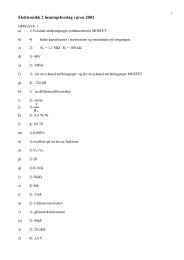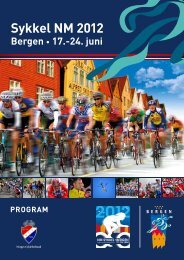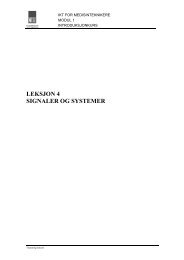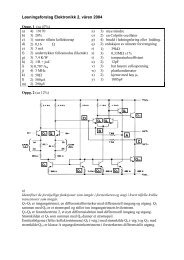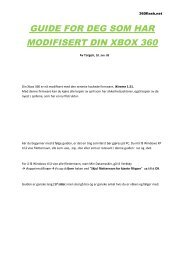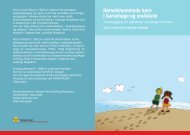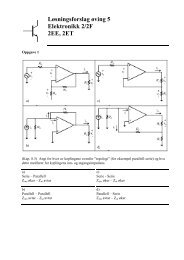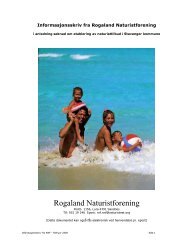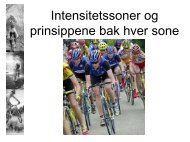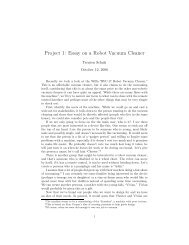The Online World resources handbook
The Online World resources handbook
The Online World resources handbook
Create successful ePaper yourself
Turn your PDF publications into a flip-book with our unique Google optimized e-Paper software.
Practical tips http://home.eunet.no/~presno/bok/12.html<br />
mailbox. Before doing that, you may have to navigate to a given file catalog (cd directory), and tell the<br />
host that the transfer is to be binary (bin). Finally, start the transfer by entering a "GET file name"<br />
command.<br />
<strong>The</strong> file will be transferred to your local mailbox computer at high speed. When the transfer is<br />
done, you logoff from the remote center to "get back" to your mailbox computer's prompt line.<br />
Now, you can transfer the file to your personal computer using communications protocols like<br />
Kermit, XMODEM, ZMODEM or whatever else is available.<br />
Note: I usually prefer Lynx for retrieval jobs using URLs like you would use with Netscape, as in<br />
"Lynx ftp://ftp.eunet.no/pub/text/online.txt".<br />
Binary files transferred as text codes<br />
If you do not have access to FTP or Lynx, you must use ordinary email for your binary transfers.<br />
Usually, email through the Internet can only contain legal character codes (ASCII characters<br />
between number 32 126). Most systems cannot transfer graphics or program files directly, since<br />
these files normally contain binary codes (which are outside this ASCII character range).<br />
<strong>The</strong> solution is to convert binary files to text codes using a utility program called UUENCODE. <strong>The</strong><br />
encoded file can be sent by ordinary email, as in this example:<br />
From TRICKLE@VM1.NoDak.EDU Fri Aug 16 16:32:37 1991<br />
Date: Fri, 16 Aug 1991 09:31:34 CDT<br />
To: presno@eunet.no<br />
Subject: Part 1/1 SIMTEL20.INF PD:<br />
<strong>The</strong> file PD:SIMTEL20.INF has been uuencoded before<br />
being sent. After combining the 1 parts with the mail headers<br />
removed, you must run the file through a decode program.<br />
Part 1 of 1<br />
begin 600 SIMTEL20.INF<br />
M6T9I;&4Z(% )351%3#(P+DE.1B`@("`@("`@("`@("`@("`@("!,87 T(')E<br />
M=FES960Z($IU;F4@,C@L(#$Y.3%=#0H "B`@(%M.;W1E.B!$=64@=&\@9&ES<br />
M:6P "AH:&AH:&AH:&AH:&AH:&AH:&AH:&AH:&AH:&AH:&AH:&AH:&AH:&AH:<br />
M&AH:&AH:&AH:&AH:&AH:&AH:&AH:&AH:&AH:&AH:&AH:&AH:&AH:&AH:&AH:<br />
6&AH:&AH:&AH:&AH:&AH:&AH:&AH:&@(Z<br />
end<br />
End of part 1 of 1<br />
When you receive a message with uuencoded text, download it to your personal computer's hard disk.<br />
Use an editor to cut out the codes and paste them to an empty work file. Using the example above,<br />
the first line in your work file should contain:<br />
begin 600 SIMTEL20.INF<br />
<strong>The</strong> last line of your work file should contain<br />
end<br />
Now, use a utility program called UUDECODE to convert the file back to its binary form (or whatever).<br />
More information about uuencoding and uudecoding is given in the MSDOS1 file mentioned above<br />
(for MS DOS computers). It has a detailed explanation, BASIC source code for making the program<br />
UUDECODE.COM, and a DEBUG script for those preferring that.<br />
Versions of UUDECODE are also available for other types of computers.<br />
Transfer of pictures<br />
In 1992, Denis Pchelkin (Protvino, Russia) was 11 years old, had two cats and one dog, and was a<br />
famous contributor of beautiful computer graphics art to the Kidlink project.<br />
<strong>The</strong> file ART019 in the KIDART catalog of the North Dakota center contains one of his creations.<br />
It is a UUENCODEd picture in GIF graphics format.<br />
Retrieve Denis' art by sending a command to listserv@listserv.nodak.edu. Put the following in the<br />
TEXT of your message:<br />
GET KIDART.ART019<br />
<strong>The</strong> LISTSERVer will return a message filled with strange uu codes. We assume that you have<br />
already retrieved the MSDOS1 file, and that you have a version of the conversion program. Your next<br />
step is UUdecoding:<br />
Read the message into an editor or a viewing program. Cut and paste the codes to a work file.<br />
11 of 13 23.11.2009 15:48



